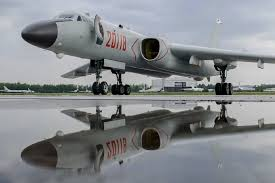China’s Xi’an H-6 bomber continues to be in the news for its ADIZ (air defense identification zone) transgression in the East and South China Seas. This old Chinese bomber has transformed into a cruise missile truck.
In July 2024, Chinese state-sponsored media showed pictures of the H-6K bomber taking off with four air-launched ballistic missiles, dubbed the YJ-21 by foreign media, an increase from the earlier capability to carry two since 2022.
It was further reported that the ballistic missile can hit stationary targets as well as slow-moving targets, including aircraft carriers, at hypersonic speeds from extended distances.
The H-6K wings appear to have been further strengthened. It can substantially increase the PLA Air Force’s (PLAAF) long-range precision strike capabilities in anti-access/area denial missions.
Chinese media is comparing the missile to Russia’s Kinzhal missile carried on the MiG-31. Though an old platform, China’s H-6 bomber remains viable and capable in the 21st century and seems ready to attack any possible target.
Strategic bombers are primarily designed for long-range bombing missions against strategic targets to diminish the enemy’s ability to wage war by limiting access to resources through crippling infrastructure, reducing industrial output, or inflicting massive civilian casualties to an extent deemed to force surrender.
Tactical bombing is aimed at countering enemy military activity and supporting offensive operations and is typically assigned to smaller aircraft operating at shorter ranges, classically near the troops on the ground or against enemy shipping.
For years, H-6K bombers were accompanied by other PLAAF military aircraft, such as J-11s, J-16s, Y-8s, Su-30s, KJ-500s, and various UAVs, for incursions into the Taiwanese and sometimes Japanese Air Defense Identification Zones (ADIZ), carrying a variety of payload munitions.
On 13 July 2017, the Japanese Air Self-Defense Force (JASDF) scrambled jets from Okinawa, intercepted, and photographed six Chinese H-6K bombers conducting long-range drills over the Bashi Channel and Miyako Strait through the Taiwanese, East China Sea, and Japanese Air Defense Identification Zones (ADIZ).
Again, on 25 May 2018, the JASDF joined the Taiwanese Air Force’s F-16 fighter jets in intercepting and photographing two H-6K bombers looping around Taiwan Island.
Since 2019, H-6s began joining Russian bombers on “Tokyo Express” patrols, overflying contested islets, triggering responses to a four-way aerial confrontation between fighters from South Korea and Japan.
In a relatively new move, Russian Su-35S and Su-30SM have been seen escorting Chinese H-6K bombers as they made probing flights toward Alaska. The bomber didn’t come closer than 350 kilometers.
The US Air Force (USAF) invariably respondsbyhscrambling its fightersg and trailing the Chinese aircraft. Though the H-6 is a regional range bomber, aerial refueling has allowed it to foray deeper and farther into the Pacific Ocean and make an operational statement to the Americans.
The joint patrols, spurred by common grievances with the United States and its allies, also give the impression that China and Russia are doubling up to magnify their perceived power.
Summarise – H-6 A Useful Asset
The H-6s have a shorter range and lower maximum payload capacity than the B-52 and Tu-95, both of which are of 1950s vintage.
H-6 has a max speed of 1030 kmph and cruises mostly below 800 kmph. Yet the aircraft is useful as a missile-carrying platform that can fire from stand-off ranges without being threatened. H-6 has a significant anti-shipping role.
Most H-6 variants retain bomb bays for gravity-bombing or mine-laying; their important armament is externally carried long-range missiles. The most notable include the heavy YJ-12 supersonic anti-shipping missile, at least two kinds of giant hypersonic air-launched ballistic missiles, and the KD-20/CJ-20 land-attack cruise missile, which also has an anti-ship variant. The H-6 crew can launch these weapons from between 500 kilometers to just over 3,000 kilometers away from their target.
PLAAF currently has nine bomber regiments and two bomber brigades (all with 20 to 30 H-6s each), operating at least six different types of H-6 bombers. It also has an additional regiment of related HD-6 aerial tankers and a training brigade at the Harbin Flight Academy using old H-6A bombers.
China’s very deep arsenal of anti-ship missiles would likely compel US carrier task forces to operate hundreds of miles east of Taiwan beyond the range of most of the missiles. But the US ships and bases could still be well within range of the H-6 bombers’ YJ-12 or YJ-100 missiles that make up the ‘long arm’ of China’s maritime attack capabilities alongside land-based DF-21D and DF-26B anti-ship ballistic missiles.
China will try to isolate Taiwan, including in a pre-hostilities blockade, which might involve long-distance naval mine-laying dropped from H-6Js. China will plan long-distance air strikes against the US airbase at Guam, those at Kadena in Japan, and also those in the Philippines.
They will try to strike front-tier Indian airfields in case of hostilities. The bomber’s near 3,500-kilometre range, combined with the 2,000-kilometre range of KD-20/CJ-10 cruise missiles, results in a deep strike range in oceans. H-6 variants will support aerial refueling and electronic warfare.
To keep the H-6 at a distance deep in its own territory will require long-range surface-to-air missiles such as S-400 and AAMs such as AIM-174B and forthcoming AIM-260 or Russian R-37M and Novator KS-172.
The H-6 has been seen operating from Hotan and Kashgar in Xinjiang, not too far from India’s Ladakh. The H-6K bombers have also operated from the Shigatse air base of Tibet, just 200 kilometers from the Indian border in Sikkim. Despite being an old platform, the H-6 remains a viable and capable bomber in the 21st century. India would have to monitor its positioning and prepare defenses against it.





